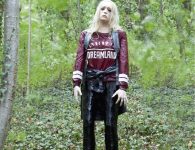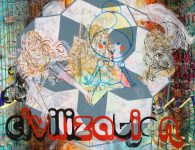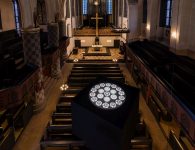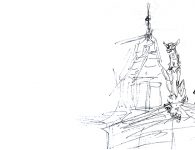„The most important thing to build a sacred place is on how we could trust us and the others at the same moment together of sharing.“
Reza Afisina (member of ruangrupa, artistic director of “documenta fifteen”)



What about religion, Reza Afisina?
I got to know Reza Afisina from Ruangrupa through the documenta project “Hypersituations” and was pleased about his willingness to answer the questions of Thomas Erne and me. This resulted in the following interview with Reza Afisina on documenta fifteen, art and religion.
CB: Dear Reza, we enjoyed documenta fifteen especially concerning its new approaches to collective working and displaying contemporary art. Thank you for taking the time to talk with us about a specific aspect of this documenta: The ideas of working as a collective and relations between worldviews and contemporary art. First of all, it would be nice if you could tell us about your work in the artists’ collective ruangrupa which is the artistic director of documenta 15.
RA: As part of introduction, I’m 45 years old and professionally I’m a new media artist, working mostly with performance art and object as well as installation. Me and Iswanto also creating this artist duo called RA.IH (Reza Afisina and Iswanto Hartono). We came from different background of study. I have studied Cinematography for field sound recordist back in the 90’s. Iswanto’s background is architect as well as an artist.
With ruangrupa, I’m not one of founder’s, but I’m involved with most of ruangrupa’s since in the college time and much involved in the beginning when ruangrupa initiated as collective artists back in year 2000 until present time.
So far the influence of my works come mostly from daily narration and city as a platform, connecting to society, community and neighboring ecosystem. As well as the most important things are, most of us in ruangrupa and GudSkul ecosystem back in Jakarta also my family are my important inspirations.
I’m not quite concern about my career path, except for keep on working together and bringing contribution also exchange of experiences with many people and ecosystem surrounding me.
TE: Is there a work of art at the documenta 15 that, for you, most precisely expresses your group’s concept – and if so, why?
RA: It’s hard for me to find the exact documenta fifteen works that express our as ruangrupa concept’s. Many of them had articulated similar gesture of collectivities that mostly we are learning from them. I guess I need to admit, most of the works in documenta fifteen interwoven most of collectives gesture in their own local communities.
TE: What is the power of working in a collective way instead of producing or curating art as a single person?
RA: Collective as power, is that we have our power to distribute the power relation into a more horizontal way. If we believe such power is an important resource that naturally we need to share and distributing it fairly.
TE: Do religions or spirituality play a role in processes of de-colonizing and de-hierarchizing art?
RA: Again, for me to embrace particular believes it’s also a gesture on how I’m related to artistic narration’s. In many societies, one’s believe also related to on how society moves towards and thinking better future for our next generation. Lots of things to be open for our thoughts. It matters on how we should position ourselves in larger society.
CB: When I visited documenta, I noticed many religious references, representations, and rituals such as the sanctification of the area between the Beuys oaks in front of the Friedericianum, the film work by Saodat Ismailova or the mirror performance in the basement of the Friedericianum. Do you have an idea of what it means when religion becomes artistic, and art becomes religious?
RA: Being religious at the same time, we could embrace all the beauties of it. For me it is considered way beyond artistic. For me the most important thing is to believe that all not perfect but we are struggling to work on perfection. We should not lose hope on working on what we believe is good to others. That’s also embedded in most artistic process.
CB: I am thinking of a video production and performance of yours that reminds me strongly of Christ and the Passion. Am I right about that? Could you tell me more about this art project?
RA: Part of my personal and individual works, some of it gets inspired by Holy Koran and even Holy Bible. Once I studied at Catholic school. I also learn a bit about the others Holy scriptures in most of believes that are embracing peace and how we dealt with our living and how we should be together in a very dynamic way, embracing differences, respecting and honoring others. And my own idea on those particular video performance work’s “what…” that’s quoted from the letter of Luke are on how I’m myself try to understand the way of how society defines punishment as physically connection and how to embrace other thoughts on what is punishment.
CB: You told me that one of your favorite pieces of art are the installations of the church of St. Kunigundis by Atis Rezistans or the Ghetto Biennale. What exactly fascinates you so much about it?
RA: Why I feel very excited about Atis Rezistans of Ghetto Biennale from Haiti (Port au Prince) at St. Kunigundis as part of documenta fifteen, is about notion of dialogues and living gesture of totally different society. But we could share warmth aim of being believers in very strong and complex narration of them society that we could as well learn and continue to understand, although not in very common thoughts, still with important messages.
CB: As an artist, how do you perceive churches and other sacred buildings – more as exhibition spaces or religiously, spiritual or completely different?
RA: For me space or even a room, area etc., are having sort of story and history in the background. Every space could deliver such of structural but also living part as personal memory within the ecosystem surrounding it. In example, you mentioned Church, for sure the structure already gives very important position. And many articulation to regards place like Church that’s become most secure and safety, aside of sacred, for many peoples, even to regards which believes peoples are stand for. This thought giving lots of very welcoming gesture as a home as well as a living room, where people could meet and greet.
CB: In your opinion, what should an ideal religious place be like? How would you build a sacred or spiritual building of the future?
RA: Religious space in my opinion is not defined by structure, although indeed we need that, but what of most believes in themselves by heart, thought and feeling peaceful and excepted as a home. Sometimes our own house could be sacred and very spiritual too, also some other places that’s considered as home to us, also sacred, respectful and give us proud of it. The most important thing to build a sacred place is on how we could trust us and the others at the same moment together of sharing.
CB: How do you perceive the outcome of this documenta so far? What do you take with you personally as a “harvest “? What is your vision of the sustainability of documenta 15?
RA: My harvest for documenta fifteen, are not only about our method of Lumbung, but also other finding within this approach on living with others ecosystems. How it will sustain it’s about on how later society will perceiving it. I couldn’t predict my future or our future, although would be good to be part of holistic gesture by keep on working and contributing passionately for good deeds in many directions and practices.
CB: What do you think the World Art Exhibition should ideally achieve?
RA: As world of art exhibition, it’s different characteristic, many layers and structures involves. It’s about on how this so-called art cultural event should articulate in very common understanding and create dialogue, not as static gesture. It’s hard but doable and if we believe that it possible could work.
CB: What has been the experience that has touched you most in connection with documenta 15 so far?
RA: The most important thing that connected us with all processes for documenta fifteen is on how we are very honor to be part of Kassel and it’s ecosystem in the society.
CB: Are there experiences that you have had through the documenta that will have a lasting impact on your curatorial and artistic work and your attitude as an artist? Has documenta 15 changed you in any way, and if so, how?
RA: I’m not coming for curatorial background, also as ruangrupa practices for more than 22 years at present. For me and us ruangrupa, we are artist’s. We mostly connected to artistic and society approach. We don’t have any formulation nor module to it. And we never had any intention to imposing our ideology and our practice. We just show it, share it and introduce it. And we never had idea to change something, we mostly try to learn all times.
CB: What do you wish for yourself as an artist, for Ruangrupa, for Indonesia, for Kassel and for the (art) world in the future?
RA: I’m always wishing that we could always do better to our society everywhere we are situated.
CB: Thank you very much for the interview!




Christina Bickel








